Your Roadmap Is a Lie
Discover the best customer experience measurement tools to enhance your customer satisfaction and loyalty. Find the perfect solutions today!
Posted by
Related reading
Stop Asking Useless Survey Questions. Steal These Instead.
Stop guessing. Get battle-tested survey questions examples to find out what your customers actually want. Real talk, no fluff. Just actionable insights.
Fix Your Customer Feedback Questionnaire Now
Revamp your customer feedback questionnaire with brutally honest advice. Get actionable insights and stop wasting your customers' time with bad surveys.
How to Collect Customer Feedback (Without Wasting Your Goddamn Time)
Stop guessing. Learn how to collect customer feedback that drives growth. A no-BS guide for founders on building products people actually want.
Let's cut the crap. You think you know what your customers want. You've got your roadmap, your feature list, your 'vision.' But every minute you spend building based on your gut is a minute you're probably getting lapped by someone who's actually listening. Ignore your customers, and you’ll be lucky to survive the quarter.
I've been there, burning cash on features nobody asked for, all while the real, money-making feedback was buried in support tickets and salty App Store reviews. You don't need another blog post telling you 'feedback is a gift.' You need a way to stop the bleeding and find the signal in the noise. This isn't about hand-holding. It's a founder-to-founder breakdown of the customer experience measurement tools that actually work, without the enterprise fluff.
We're going to cover the platforms that help you systematically listen, analyze, and act on what your users are screaming at you. For each tool, you'll get a no-BS look at what it does, who it's for, and whether it's worth your time. We'll also see how they stack up against broader strategies like using the top reputation management tools to manage your brand's public face.
If you're ready to stop guessing and start building what people will actually pay for, read on. If not, enjoy the board meeting where you explain why churn is up... again.
1. Backsy.ai: The Unfiltered Truth Machine
Standard customer surveys are a joke. Asking someone to compress their complex feelings about your product into a 1-5 star rating is lazy and generates data that’s just clean enough to be misleading. Backsy.ai is built on the premise that raw, unstructured feedback is where the real gold is hiding. It’s for founders who are tired of guessing and want to tap directly into their customers’ unfiltered thoughts.
Instead of rigid forms, Backsy gives customers an open channel to speak or type their minds. It then uses AI to analyze these qualitative rants, ramblings, and praises, identifying recurring pain points, unexpected delights, and genuine user sentiment. This isn't for generating vanity metrics; it's for finding the specific, actionable "why" behind your churn rate. Think of it as a 24/7 focus group that tells you what you need to hear, not what you want to hear.
Key Details & How It Works
- Core Function: Collects open-ended text and voice feedback and uses AI to perform thematic analysis and sentiment scoring.
- Best Use Case: Diagnosing an urgent problem like a spike in trial cancellations or validating a high-stakes feature idea before committing dev resources.
- Implementation: A simple widget or link you can share via email, in-app pop-ups, or QR codes.
- Pricing: Tiered subscription based on feedback volume, with plans designed to scale from early-stage startups to larger enterprises.
Takeaway: Stop asking customers to rate you; give them a place to vent, and Backsy will turn their rants into your roadmap.
2. Qualtrics XM: The Corporate-Grade CX Engine
If you’re moving past startup gut-feel and need to build a structured, scalable CX program that your board will understand, you’re entering Qualtrics XM territory. This isn't a scrappy tool; it's the enterprise behemoth for systematically measuring data across every touchpoint. While other tools focus on one piece of the puzzle, Qualtrics aims to be the entire customer experience measurement tools ecosystem for a mature company. It's built for complexity—think multi-language surveys, complex logic flows, and deep integrations. This is what you use when "customer experience" becomes a department, not a side-hustle.
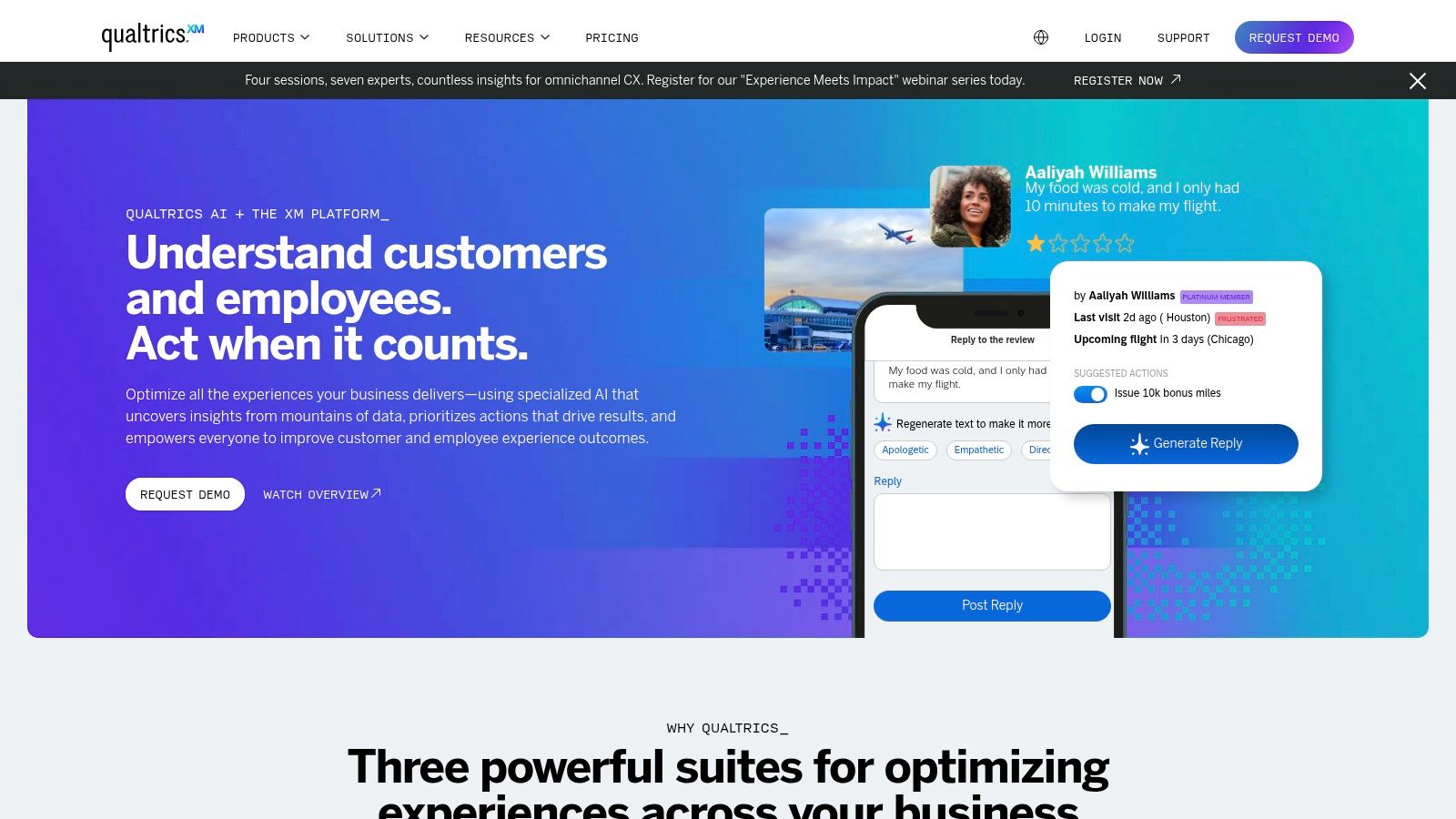
Key Details & How It Works
- Core Function: An all-in-one platform for creating and analyzing sophisticated customer surveys with deep analytics and predictive intelligence.
- Best Use Case: Establishing a comprehensive Voice of the Customer (VoC) program in a large organization to track metrics like NPS and CSAT over time.
- Implementation: Expect a significant setup process. Unlocking its full power often requires dedicated administrator-level expertise.
- Pricing: Enterprise-focused with custom pricing. A serious investment, generally prohibitive for smaller businesses.
Takeaway: When you need an irrefutable, enterprise-wide view of customer sentiment, Qualtrics is your fortress of data.
3. Medallia: The Enterprise Command Center
For a startup, using Medallia is like using a sledgehammer to crack a nut. But for large organizations with complex, multi-channel customer journeys, it’s the command center. This isn’t a quick feedback widget; it's an end-to-end customer experience measurement tool designed for enterprises that need to ingest feedback from every conceivable touchpoint, from call center transcripts to social media mentions. Medallia’s power is in consolidating disparate data streams into a single view, connecting operational data (like purchase history) with experience data (like survey scores). The downside? Its sheer scope can be overwhelming.

Key Details & How It Works
- Core Function: Captures and analyzes customer feedback signals from dozens of channels and integrates it with operational data for a holistic view.
- Best Use Case: Large-scale enterprises in hospitality, retail, or finance that need to monitor and manage CX across thousands of locations.
- Implementation: A complex, enterprise-level deployment requiring a significant integration project.
- Pricing: Custom enterprise pricing. This is a major investment, so expect a full sales process.
Takeaway: When you need to connect every single customer signal across a massive organization, Medallia is your mission control.
4. InMoment: The Enterprise CX Intelligence Engine
Most customer experience measurement tools give you a keyhole view of a much larger picture. InMoment is for when you've outgrown siloed feedback and need a 360-degree view. It’s built for unifying feedback from everywhere—voice calls, video testimonials, surveys, and social media—into one coherent intelligence platform. This isn’t about just collecting data; it’s about connecting disparate dots. InMoment uses AI to analyze conversations from your contact center and find themes in open-text survey responses simultaneously, moving beyond channel-specific metrics to a holistic understanding.

Key Details & How It Works
- Core Function: An Experience Improvement (XI) platform that centralizes feedback from voice, text, and video, using AI to deliver unified analytics.
- Best Use Case: Large organizations needing to integrate feedback from multiple departments to create a single source of truth for the customer experience.
- Implementation: A significant undertaking, requiring integration with various business systems. It’s a strategic platform deployment.
- Pricing: Sold on an enterprise model with custom quotes. Not for the faint of heart or small of budget.
Takeaway: Stop looking at your customer experience through a straw; use InMoment to get the panoramic view you actually need.
5. HubSpot Service Hub: The All-in-One Command Center
If your business already lives inside the HubSpot ecosystem, using a separate feedback platform is just creating data silos. HubSpot Service Hub isn’t just a tool; it’s an integrated extension of your entire customer relationship. It's built for systematically embedding standard metrics like NPS, CSAT, and CES directly into your service and marketing workflows. A low CSAT score doesn't just sit on a dashboard; it can automatically trigger a support ticket, add the customer to a re-engagement sequence, and flag the account. It’s less of a pure listening tool and more of a complete operational response system.

Key Details & How It Works
- Core Function: Creates and deploys customizable surveys (CES, NPS, CSAT) and integrates the results directly into the HubSpot CRM and automation workflows.
- Best Use Case: Teams already using HubSpot who need to connect feedback directly to service tickets, contact records, and marketing campaigns.
- Implementation: If you're on HubSpot, it's native. Build surveys and distribute them through email or chat, with all data feeding back into the CRM.
- Pricing: Available through tiered plans, starting with free tools. Key survey features are part of the paid Professional and Enterprise tiers.
Takeaway: Stop treating feedback as isolated data; use HubSpot Service Hub to turn customer sentiment into an automated, operational trigger.
6. Zendesk: The Support Ticket Goldmine
Your support desk isn't a cost center; it's a real-time feedback pipeline you're probably ignoring. While many tools focus on proactive surveys, Zendesk excels as a customer experience measurement tool by analyzing the reactive feedback you’re already getting: every support ticket, frustrated email, and chat message. It’s where customers tell you exactly what’s broken. Zendesk shifts the focus from asking new questions to dissecting existing conversations, turning individual complaints into measurable trends. It's less about discovering unknown problems and more about rigorously measuring the known ones costing you money.
Key Details & How It Works
- Core Function: A centralized platform for customer support with built-in tools for CSAT surveys, ticket analysis, and performance reporting.
- Best Use Case: For teams wanting to measure and improve the CX specifically as it relates to support quality, product friction, and issue resolution.
- Implementation: As a full help desk, implementation is more involved than a simple widget. It requires migrating support channels.
- Pricing: A wide range of tiered plans, from basic ticketing systems for small teams to comprehensive enterprise solutions.
Takeaway: Stop treating support as a chore; use Zendesk to mine your tickets for a data-backed roadmap to a better product.
7. Hotjar: The Digital Body Language Decoder
Analytics tell you what users do, but that’s like knowing someone left a room without knowing they slammed the door. Hotjar shows you the digital body language behind the metrics. It closes the gap between cold data and the actual human struggling to find your checkout button. Session recordings let you watch a user’s journey, complete with rage clicks and confused mouse movements. Heatmaps reveal where people are actually clicking, often exposing flaws in your design assumptions. It’s less about asking for opinions and more about observing behavior to understand what’s broken.
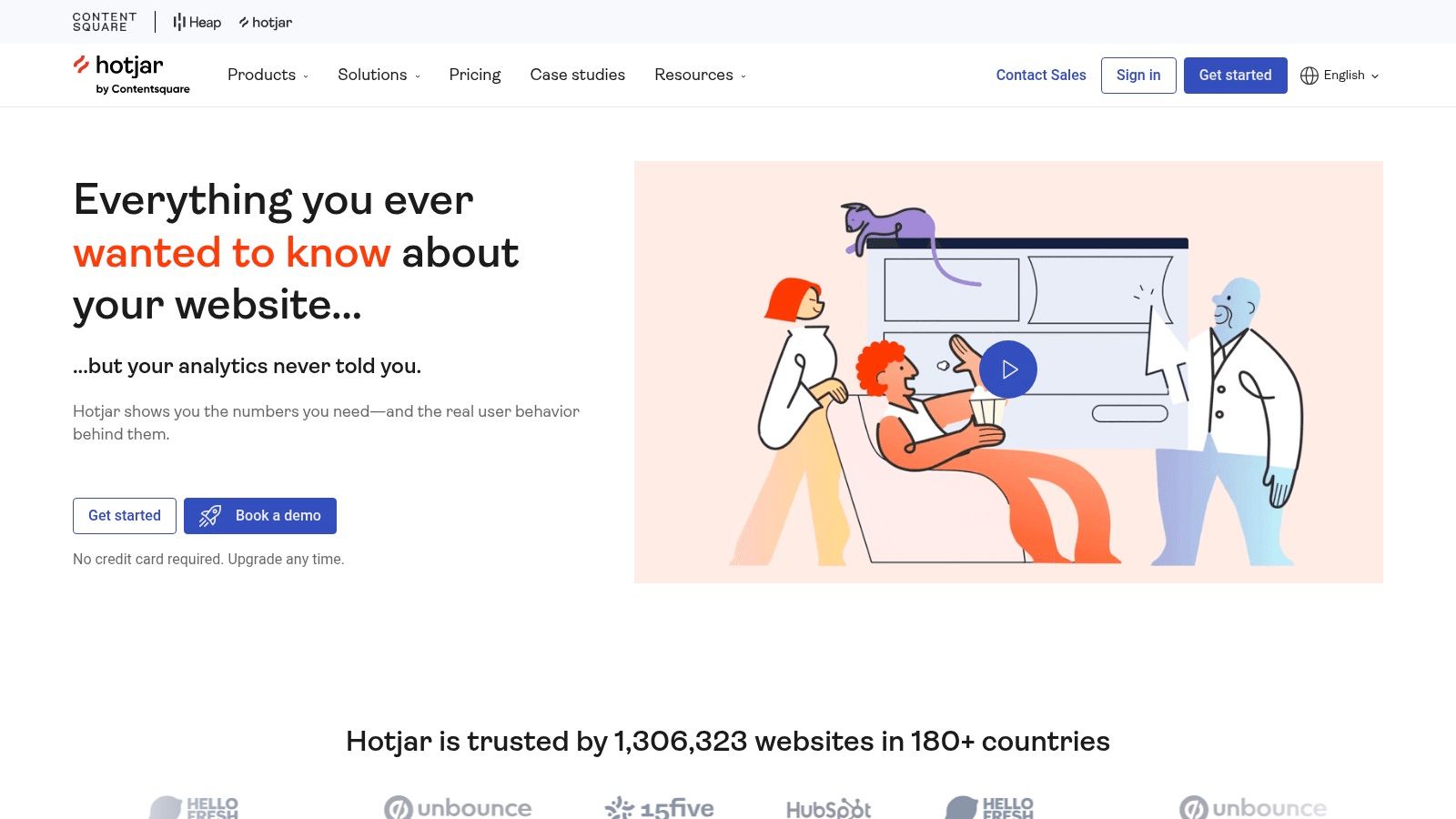
Key Details & How It Works
- Core Function: Visualizes user behavior through session recordings, click/move/scroll heatmaps, and on-site feedback widgets.
- Best Use Case: Optimizing website funnels, improving UI/UX based on real user interactions, and identifying usability issues you never knew existed.
- Implementation: Requires installing a single JavaScript tracking code snippet into your website’s header.
- Pricing: A freemium model with a generous free plan. Paid plans scale based on the number of sessions you need to capture.
Takeaway: Stop debating UI changes in meetings and start watching what users actually do; Hotjar is your over-the-shoulder proof.
8. CustomerGauge: The B2B Churn Killer
Most feedback tools treat every user the same, a fatal flaw in B2B. Losing a single enterprise account can cripple a quarter. CustomerGauge is one of the only customer experience measurement tools built to prevent that disaster. It forces you to connect every piece of feedback directly to the revenue it represents, rejecting the vanity metric of a high-level company NPS score. It's for account managers who know that not all feedback is created equal. The platform links survey data to your CRM, showing you which accounts are at risk, which are ripe for upsell, and which detractors are about to nuke your revenue.
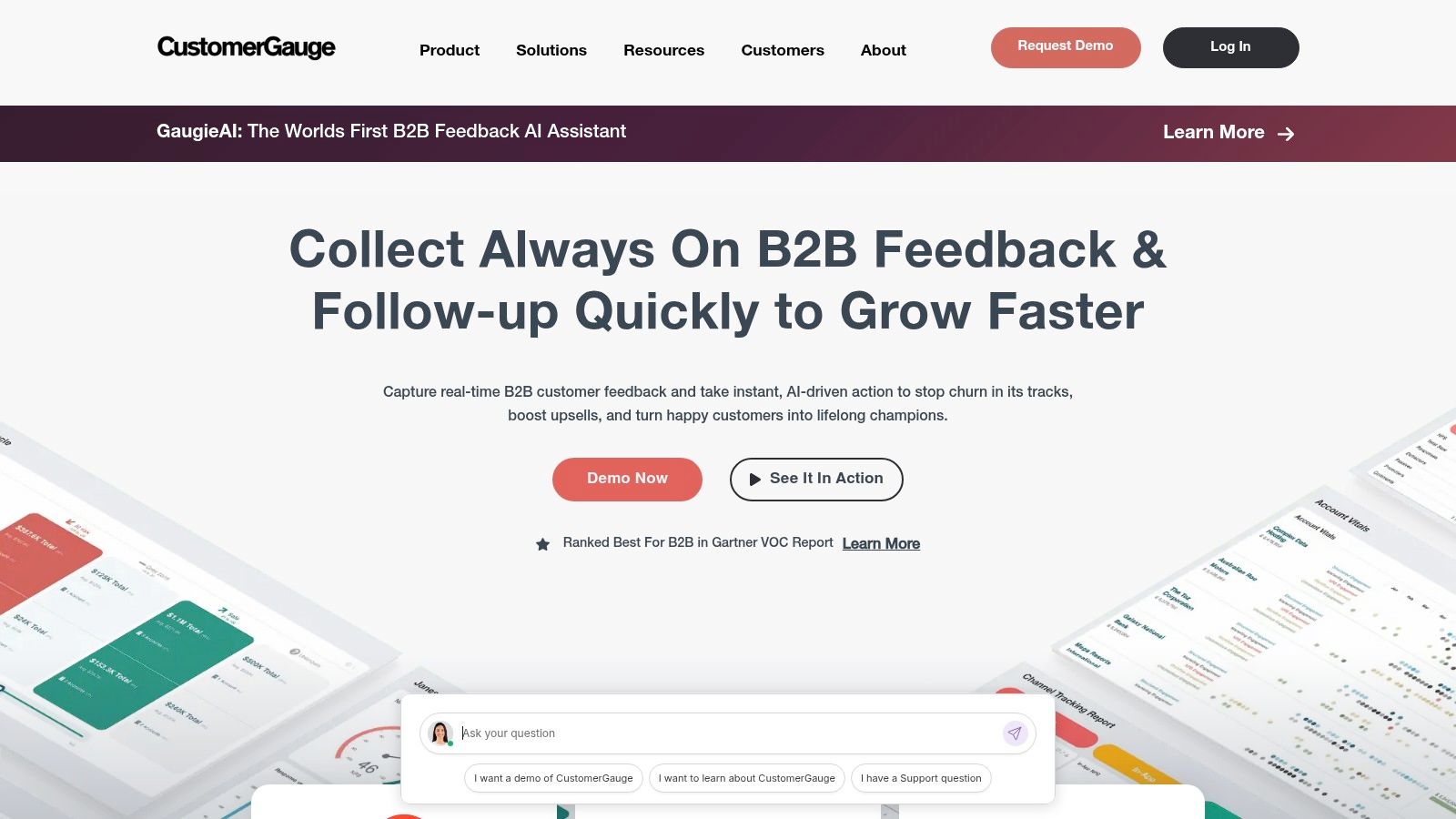
Key Details & How It Works
- Core Function: Ties customer feedback (NPS, etc.) directly to financial data from your CRM to prioritize actions based on account value.
- Best Use Case: High-touch B2B companies needing to proactively identify and mitigate churn risk within their most valuable accounts.
- Implementation: Requires integration with your CRM (like Salesforce) to link feedback to specific accounts and revenue figures.
- Pricing: Enterprise-level pricing tailored to B2B needs. Contact them for a quote.
Takeaway: Stop treating all customers equally; let CustomerGauge show you which relationships are actually paying the bills so you can save them.
9. SurveyMonkey: The Ubiquitous Feedback Engine
If you’ve ever filled out an online survey, you’ve probably used SurveyMonkey. It's the OG, the default tool for asking a structured set of questions. While modern platforms focus on niche analytics, SurveyMonkey remains one of the most versatile customer experience measurement tools because of its sheer scale and ability to get a functional survey out the door in minutes. This isn’t the tool for deep, unstructured analysis; it's the workhorse for quantitative feedback like Net Promoter Score (NPS) or Customer Satisfaction (CSAT). Its power is its simplicity and reach.
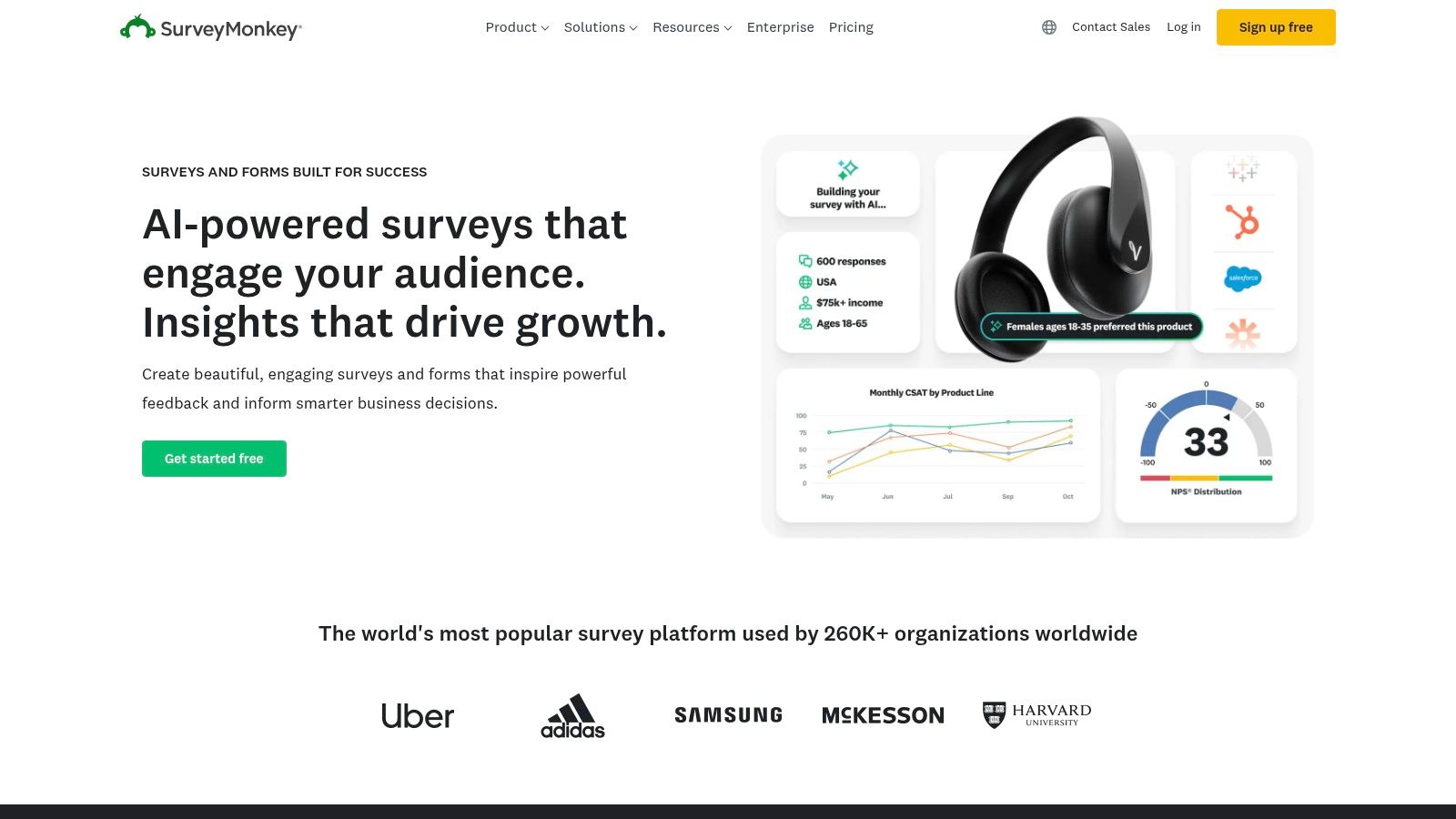
Key Details & How It Works
- Core Function: Creates, distributes, and analyzes online surveys with a massive library of templates.
- Best Use Case: Running standardized CX metric surveys like NPS or CSAT, gathering post-event feedback, or conducting basic market research.
- Implementation: No technical skill required. Build surveys in a web editor and share them via a link.
- Pricing: A limited free plan, with paid business plans required for advanced features like logic and data exports.
Takeaway: For structured, quantitative feedback at scale, SurveyMonkey is the reliable industry standard that gets the job done with minimal fuss.
10. Forsta: The Enterprise-Grade CX Engine
If you’re running a complex, global operation, you can’t rely on a simple widget. You need an industrial-strength machine. Forsta is one of the customer experience measurement tools built for this level of complexity, designed for large organizations that need a single source of truth for CX data. This isn’t a quick survey tool; it’s a full-stack experience platform that unifies disparate feedback streams, whether it’s a formal NPS survey, a social media mention, or a support call transcript. It's for when "we should listen to customers" evolves into a core business function tied to P&L.
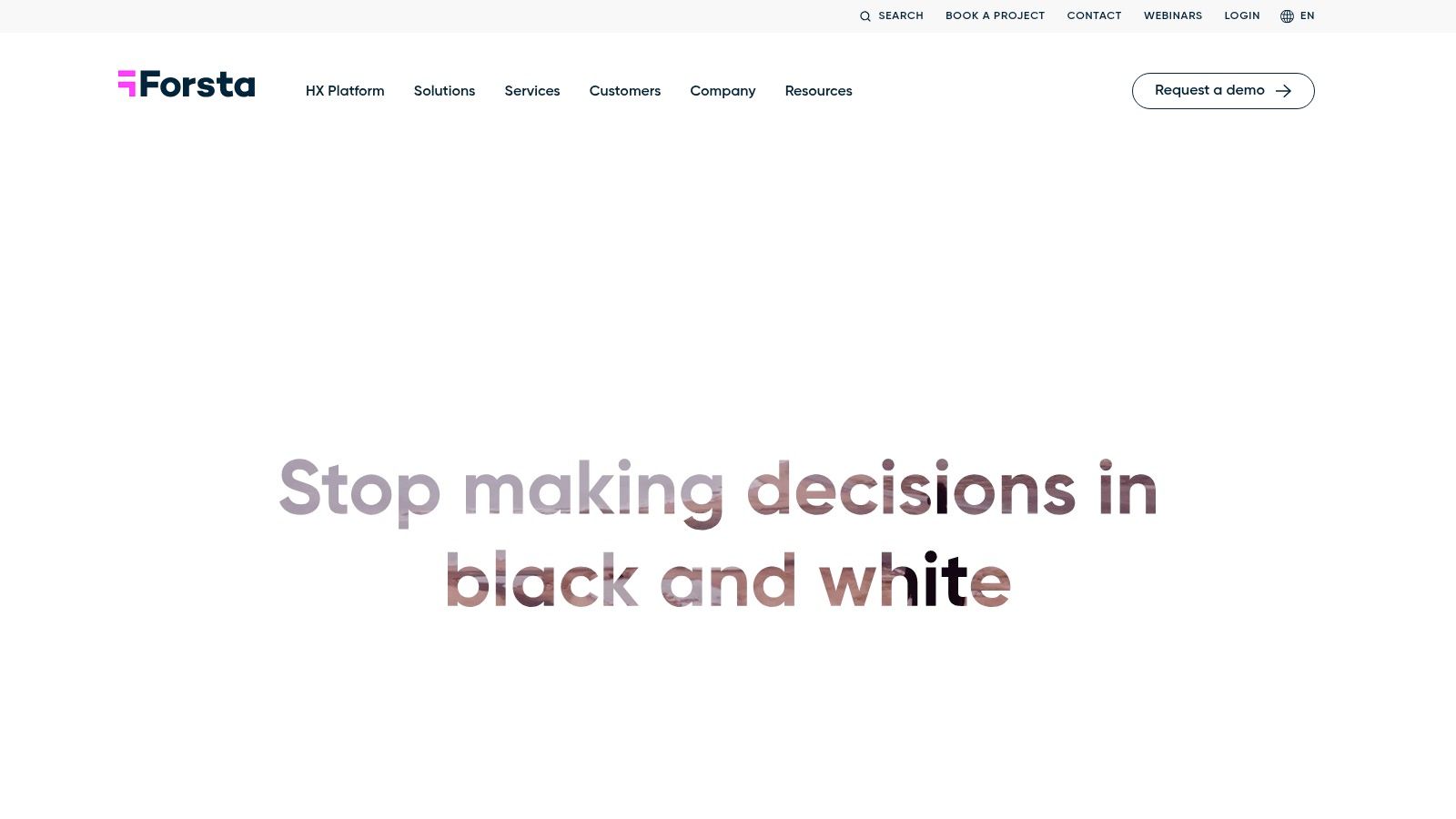
Key Details & How It Works
- Core Function: A comprehensive, multi-channel platform for collecting, analyzing, and acting on customer and employee feedback at scale.
- Best Use Case: Large, multi-national corporations needing to centralize CX management and standardize reporting across different business units.
- Implementation: An enterprise solution that requires strategic planning and integration, not a plug-and-play tool.
- Pricing: Custom pricing model based on the scope of the deployment. You’ll need to engage their sales team.
Takeaway: When your CX program needs to grow up and get a real job, Forsta provides the corporate infrastructure to make it happen.
11. Retently: Automating the Satisfaction Scorecard
Running NPS or CSAT surveys manually is a quick path to burnout. You’re either drowning in spreadsheets or the data is garbage. Retently is one of the customer experience measurement tools designed to put this entire process on autopilot. It systematizes the distribution of NPS, CSAT, and CES surveys, ensuring you get a consistent pulse on customer sentiment at critical journey touchpoints. It’s not about reinventing the wheel; it’s about making the wheel turn without you having to push it. It turns a vague metric into a specific to-do list.

Key Details & How It Works
- Core Function: Automates the sending and analysis of NPS, CSAT, and CES surveys via various channels and provides robust analytics.
- Best Use Case: Establishing a continuous, automated feedback loop to monitor and improve core CX metrics without a full-time employee.
- Implementation: Integrates with your existing stack (CRM, helpdesk) to trigger surveys based on user actions.
- Pricing: A tiered pricing model based on the number of surveys sent per month.
Takeaway: Stop treating NPS as a quarterly chore; let Retently turn it into a daily, automated source of truth.
12. Zonka Feedback: The Omnichannel Feedback Hub
If your customers interact with you in more places than just your website, you're bleeding feedback at every offline touchpoint. Zonka Feedback is designed to capture sentiment everywhere, from a trade show kiosk to a QR code on a restaurant table. It’s for businesses that need to standardize how they collect metrics across both digital and physical worlds. It moves beyond web surveys, allowing you to deploy feedback forms on tablets in-store (even offline) or send them via SMS. This omnichannel approach gives you a holistic view of your service quality.
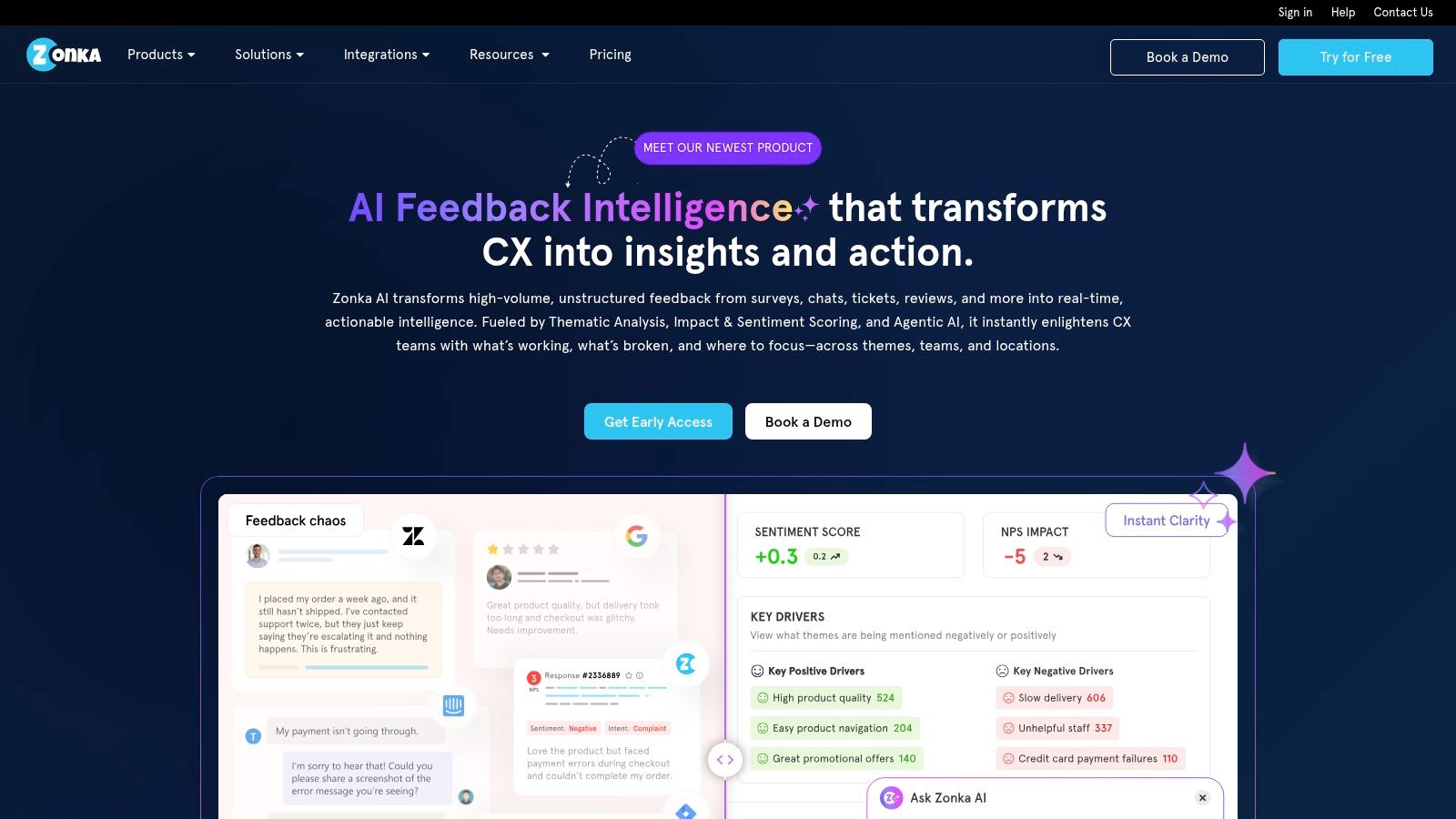
Key Details & How It Works
- Core Function: Deploys multi-channel surveys (NPS, CSAT, CES) across web, email, SMS, and offline kiosks, then centralizes the data.
- Best Use Case: Hospitality, retail, or event-based businesses needing to capture in-person feedback and connect it with digital data.
- Implementation: Involves choosing your channels, customizing templates, and deploying them. Offline use requires setting up devices.
- Pricing: Tiered subscription model. You’ll need to contact their sales team for specifics.
Takeaway: Stop assuming your digital experience is the whole story; use Zonka Feedback to measure the moments you can't see from your desk.
The Right Tool for the Job: A No-BS Comparison
| Platform | Core Function | Best For 👥 | Biggest Weakness 👎 |
|---|---|---|---|
| Backsy.ai 🏆 | AI analysis of unstructured feedback | Founders who need the "why" fast | Less focused on traditional NPS/CSAT scores |
| Qualtrics XM | Enterprise-grade survey engine | Huge companies with CX departments | Overkill and too expensive for most |
| Medallia | Enterprise omnichannel command center | Global brands (retail, finance) | Insanely complex implementation |
| InMoment | Enterprise AI feedback intelligence | Large orgs with multiple channels | Black box pricing and long sales cycle |
| HubSpot Service Hub | Integrated CRM/service feedback | Teams already deep in HubSpot | Useless if you're not in the ecosystem |
| Zendesk | Support ticket & CSAT analysis | Support-driven businesses | Limited view outside the support queue |
| Hotjar | Visual user behavior (heatmaps) | Product managers and UX designers | Doesn't tell you the "why" on its own |
| CustomerGauge | B2B revenue-linked feedback | B2B SaaS with high-value accounts | Not built for high-volume B2C |
| SurveyMonkey | Fast, simple quantitative surveys | Anyone needing a quick NPS score | Superficial data, lacks deep insights |
| Forsta | Full-stack enterprise experience plat. | Multi-national corporations | Another complex, expensive enterprise tool |
| Retently | Automated NPS/CSAT tracking | Teams wanting set-it-and-forget-it | Can become a vanity metric machine |
| Zonka Feedback | Digital + physical feedback capture | Retail, hospitality, events | Overkill for purely digital businesses |
Your Roadmap Is a Lie Until It's Validated.
Let’s be honest. Your beautiful, color-coded product roadmap is pure fiction. It’s a work of art based on assumptions and what you think your customers want. A well-intentioned lie, maybe, but one that will bankrupt you if you believe it for too long.
The gap between your roadmap and market reality is where startups go to die. This entire article, this deep dive into twelve different customer experience measurement tools, isn't about finding a shiny new toy. It's about finding a weapon to kill your bad assumptions before they kill your business.
Don't Drown in Data or Settle for Vanity
We've walked through a battlefield of options. On one side, you have the enterprise behemoths like Qualtrics and Medallia. They promise a 360-degree view but often deliver a 360-degree headache. You’ll spend more time implementing the system than listening to the feedback.
On the other side, you have classic survey tools like SurveyMonkey. They’re simple and will give you a beautiful NPS chart. But that score is a vanity metric. It tells you what but gives you zero insight into why. A high score feels good; a low score feels bad. Neither tells you what to build next Tuesday.
The Real Job: Finding the "Why"
Your actual job isn't to collect scores. It’s to excavate the "why" from the messy, unstructured signals your customers are sending every day. The gold isn't in a 1-10 rating. It’s in the offhand comment during a support chat, the frustrated sigh in a Hotjar recording, or the feature request buried in a Reddit thread.
Your selection process for one of these tools should be ruthless: Which one gets me to the actionable truth the fastest?
Choosing a tool is the easy part. The hard part is changing your mindset. Stop asking customers to validate your genius ideas. Start building a system to listen to their problems. Your gut is not a strategy. Your assumptions are liabilities. The only thing that matters is what the people paying you are thinking, and most of them aren't going to fill out your damn survey. Find a better way to listen.
Tired of begging for survey responses that tell you nothing? Stop guessing and automatically analyze the customer feedback you already have from support tickets, sales calls, and online reviews with Backsy.ai.